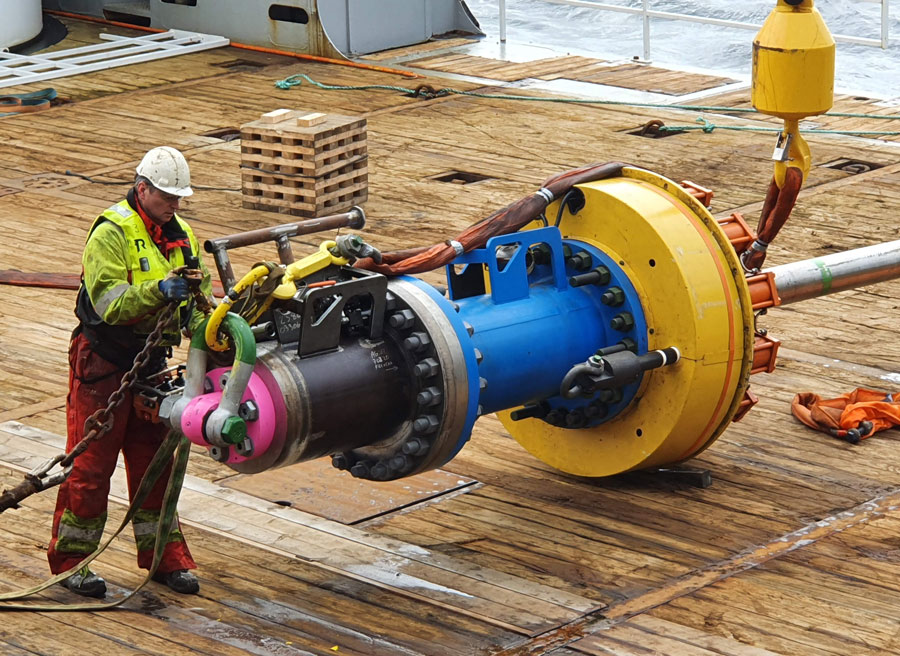
(Source: Shutterstock.com)
[Editor's note: This article originally appeared in the January issue of E&P Plus. Subscribe to the digital publication here.]
Vessel-deployed subsea wellhead cutting system to reduce carbon emissions
Baker Hughes has released its Terminator vessel-deployed subsea wellhead cutting system. The system can reduce fuel consumption with its 100-hp motor and is also smaller and lighter compared to the original 1,000-hp abrasive water cutting system typically used on similar types of vessel-based operations. The Terminator technology affirms Baker Hughes’ commitment to energy transition by helping customers decarbonize oil and gas operations. Using a mechanical wellhead removal method, the system has already proven its capabilities by successfully cutting a subsea wellhead from an abandoned exploration well owned by Wintershall DEA in Norway. Baker Hughes worked with Wintershall DEA to cut the subsea wellhead from an abandoned exploration well in 360-m water depth in only 35 minutes. By comparison, alternative abrasive cutting methods could take as long as 5 to 6 hours for the cut alone. The Terminator system can be deployed from a vessel and uses a mechanical cutter, rather than water jet cutting methods of conventional systems, to eliminate associated risks with high pressures.

Tracking tool to reduce emissions and improve operations
Geosite has released a new emissions tracking tool called EMIT for the energy industry. EMIT fuses data from multiple sources to provide energy companies with software for monitoring emissions from all their assets. The tool tracks locations of high methane emissions, the scale and scope of incidents, and provides comprehensive intel for complete situational awareness and advanced analytics for predictive maintenance and incident response. Combined with Geosite’s communications and project management capabilities, which enable remote operations and mitigation efforts, operators can now lower unwarranted methane emissions events and manage their assets by exception.
Companies partner to accelerate low-carbon technologies
Gas Technology Institute (GTI) and the Electric Power Research Institute (EPRI) have announced a five-year joint initiative to accelerate the development and demonstration of low-carbon energy technologies. With increasingly ambitious decarbonization goals from private companies and governments alike, existing technology is not enough to achieve those targets. The Low-Carbon Resources Initiative (LCRI) is an international collaborative spanning the electric and gas sectors that will help advance global, economy-wide deep decarbonization. With 18 anchor sponsors, the LCRI leverages the collaborative research model employed by both EPRI and GTI, bringing industry stakeholders together to conduct clean energy R&D for society’s benefit. Seeded with $10 million from the EPRI collaborative, funding for the initiative is expected to be leveraged many times over its $100 million target through public and private collaboration.
Multigas detector to monitor hazardous gases
Concentrations of hazardous substances in the ambient air at a work place should not exceed specified limit values, and monitoring these low values is a demanding task. Dräger has released Dräger X-act 7000 to measure carcinogenic and toxic substances in the lower ppb range. The range of gases to be measured is being constantly expanded. The measurement-sensitive system of the X-act 7000 is based on colorimetric chemical sensor technology and measures even the lowest ppb concentrations. It can replace conventional laboratory analysis and delivers exact reliable results directly on site. False-positive measurement results and false alarms can be largely reduced. This tool saves time and costs and is easy to use. After an automatic self-test, the X-act 7000 analysis system is immediately ready for use. The user controls the measurement task via the three-button operation unit and the 2.4-inch color display. The measurement result, location and time can be stored in the internal data logger and read out with the Dräger CC Vision software. The Dräger X-act 7000 can be used with the Dräger X-am pump by connecting to it with a small connecting adapter. This makes it possible to measure carcinogenic and toxic substances in the ppb range even in inaccessible locations.

Fiber-optic sensing-based monitoring tool for CCS
Silixa has released Carina CarbonSecure, its distributed acoustic sensing (DAS) based technology for continuous or on-demand monitoring of all stages of carbon capture and storage (CCS) operations. The new tool offers offshore and on-land operators the necessary monitoring measures with a reduced cost and environmental impact of their CCS facilities. The tool enables operators to provide the assurance to regulators and communities necessary to expand CCS adoption worldwide. Carina CarbonSecure delivers ultrahigh resolution, densely sampled acoustic data for real-time continuous and/or on-demand monitoring. Elements of the tool include microseismic monitoring and passive seismic throughout the lifetime of a CO2 storage facility. The system also includes 3D vertical seismic profiling, time-lapse seismic, well-integrity and leak detection to ensure maximum safety over the various stages of CCS development.
Carina CarbonSecure is a reservoir management tool. It can be deployed to assess the viability of geological formations for carbon storage during site characterization; monitor microseismic activity during the injection phase; ensure well and storage integrity when CO2 is being injected; and provide 4D monitoring of the CO2 plume migration throughout the lifetime of the facility.
New carbon capture technique for power plants
Scientists from Exxon Mobil, University of California, Berkeley and Lawrence Berkeley National Laboratory have discovered a new material that could capture more than 90% of CO2 emitted from industrial sources, such as natural gas-fired power plants, using low-temperature steam, requiring less energy for the overall carbon capture process. Laboratory tests indicate the patent-pending materials, known as tetraamine-functionalized metal organic frameworks, capture CO2 emissions up to six times more effectively than conventional amine-based carbon capture technology. Using less energy to capture and remove carbon, the material has the potential to reduce the cost of the technology and eventually support commercial applications. By manipulating the structure of the metal organic framework material, the team of scientists and students demonstrated the ability to condense a surface area the size of a football field into just 1 gram of mass—about the same as a paperclip—that acts as a sponge for CO2. Additional R&D will be needed to progress this technology to a larger scale pilot and ultimately to industrial scale. The research successfully demonstrated that these hybrid porous metal-organic materials are highly selective and could capture more than 90% of the CO2 emitted from industrial sources. The materials have much greater capacity for capturing CO2 and can be regenerated for repeated use by using low-temperature steam, requiring less energy for the overall carbon capture process.
Environmentally friendly products to clean up oil spills
Green Boom has released a number of biodegradable, water repellent oil-only absorbents. The line of ecofriendly absorbent products works for oil spill prevention, response and remediation. The company is dedicated to producing a variety of products that can be used in marine, land and industrial environments to clean up oil spills and ensure a greener future. Green Boom’s products are made from biomass up-cycling technologies that use sustainably sourced agricultural wastes and textiles. Green Boom has created a technology that converts renewable, biodegradable and low-value agricultural materials into water-repellent, oil-only absorbents. Green Boom products are water repellent and are made up of fast-wicking materials that reduce clean up time and labor.
Editor’s note: The copy herein is compiled from press releases and product announcements from service companies and does not reflect the opinions of Hart Energy. Submit your company’s updates related to new technology products and services to Faiza Rizvi at frizvi@hartenergy.com.
Recommended Reading
Marketed: Sage Natural Resources 34 Well Package in Tarrant, Wise Counties, Texas
2024-02-02 - Sage Natural Resources retained EnergyNet for the sale of a 34 package (ORRI) in Tarrant and Wise counties, Texas.
Marketed: Mississippian Play Opportunity in Blaine County, Oklahoma
2024-02-02 - An undisclosed seller retained EnergyNet for the sale of a Mississippian play opportunity in the Webb 15-22-1XH Well in Blaine County, Oklahoma.
Marketed: EnCore Permian Holdings 17 Asset Packages
2024-03-05 - EnCore Permian Holdings LP has retained EnergyNet for the sale of 17 asset packages available on EnergyNet's platform.
Marketed: Bendel Ventures 73 Well Package in Texas
2024-03-05 - Bendel Ventures LP has retained EnergyNet for the sale of a 73 well package in Iron and Reagan counties, Texas.
Marketed: Stone Hill Minerals Holdings 95 Well Package in Colorado
2024-02-28 - Stone Hill Minerals Holdings has retained EnergyNet for the sale of a D-J Basin 95 well package in Weld County, Colorado.
